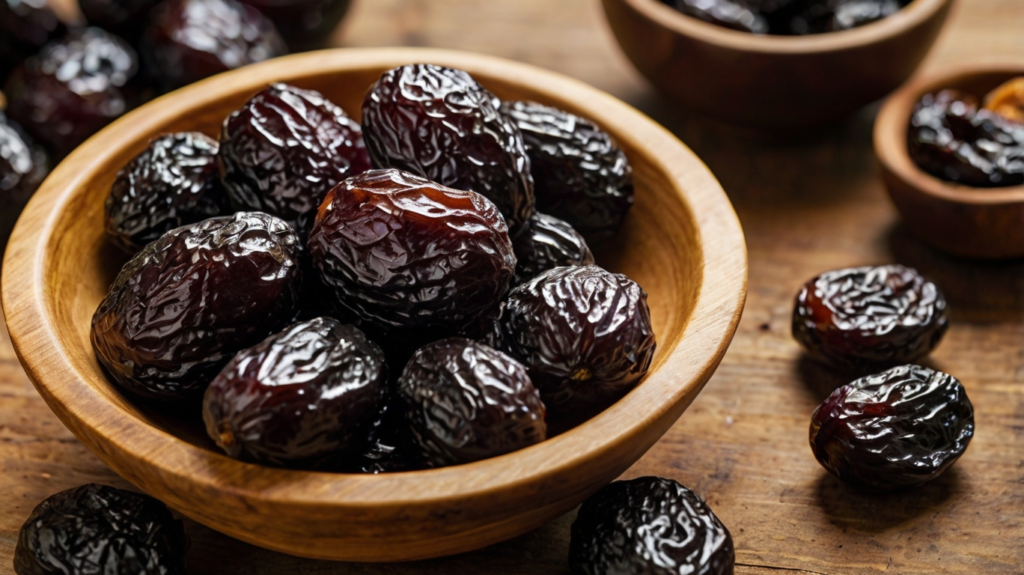
12 Benefits of dried prunes
Prunes are probably the most underappreciated of the dried fruits that people do not pay much heed to, among their favorite dates or dried cranberries. Yet these wrinkly delights are packed with impressive nutrition. They, too, must have their moment in the sun.
A good candidate for prunes should have a high sugar content and
converts well to the drying process. Though all dried plums are technically prunes, not all plum varieties make good prunes.
Health benefits
1: Digestive Health and Regularity
2: Bone Strength and Osteoporosis Prevention
3: Heart Health Support
4: Blood Sugar Control
5: Weight Management Support
6: Antioxidant Protection
7: Vision Support
8: Anemia Prevention
9: Immune System Enhancement
10: Anti-Inflammatory Properties
11: Skin Health Promotion
12: Culinary Versatility
Introduction
Prunes have been dehydrated for ages and praised for their sweet multi flavor, and incredible health benefits are on top even in modern times. A lot of time, they find themselves at the back of the pantry or are typecast as some kind of digestive solution; surely, they have more potential in our diets.
Dried prunes are in fact nothing more than dried plums. This humble offering carries an incredible load of nutrition that pretty much supports every system in the human body.
In a society that tends to follow and quickly forget health fads and superfoods, dried prunes have persistently proven scientifically based benefits and are nutritional dynamite.
They help with bone development and strengthen the skeleton, boost digestion, and may also lower the chances of getting conditions related to chronic diseases
What Are Dried Prunes?
Dried prunes are the dehydrated form of European plums (Prunus domestica), specifically cultivated varieties that lend themselves well to drying. Though all dried plums are technically prunes, not all plum varieties make good prunes.
The most common variety used for commercial prune production is the La Petite d’Agen, originally from France but now predominantly grown in California’s Central Valley, which produces over 40% of the world’s dried prunes.
The transformation from plum to prune involves a careful dehydration process that concentrates the fruit’s sugars and nutrients while preserving its beneficial compounds.
Historically, prunes were sun-dried, but modern commercial production typically uses dehydrators with controlled temperature and humidity to ensure consistent quality and food safety.
Benefits of dried prunes
Benefit # 1: Digestive Health and Regularity

One of the most notable benefits of dried prunes is its impact on digestive health. They’re a natural laxative that keeps people going to the bathroom regularly and prevents constipation, a digestive issue that plagues young and older populations alike and it’s a well known and scientifically supported .
Research has demonstrated that dried prunes possess a unique cocktail of dietary properties that work hand in hand to promote a healthy digestive system.
In no small part, dried prunes are an excellent source of soluble and insoluble fiber, with 3 grams in every 40 gram serving.
Adding fiber to your diet adds volume to stool, helping it soft to maneuver through the intestines and digestive system.
In addition, insoluble fiber helps to slow down transit time through the intestines while soluble fiber creates a gel like substance that softens stool to make it easier to pass.
In addition to fiber, natural, scientific properties exist, such as sorbitol and phenolic compounds that act like a laxative when it comes to dried prunes.
Sorbitol is a sugar alcohol compound not fully absorbed by the body and thus draws water through the intestines, further softening stool while phenolic compounds stimulate contractions of the intestinal system to better move contents through the digestive system.
For example, A 2011 study published in Alimentary Pharmacology and Therapeutics demonstrated that they are superior to psyllium (an often used fiber additive) for people who want effective treatment of mild to moderate constipation.
Compared to psyllium, dried prunes increased stool frequency and improved consistency over time for subjects where psyllium did not cause any frequency changes throughout the experimental period.
Even beyond constipation relief, other digestive benefits exist thanks to their prebiotic properties, serving as food for essential bacteria, meaning that the microbiome regulated within intestines may benefit from dried prunes, as well.
Essentially, this microbiome has become an increasingly important part of digestive health and promotes immune function and mood regulation.
“Dried plums (prunes) are safe, palatable and more effective than psyllium for the treatment of mild to moderate constipation, and should be considered as a first-line therapy.” Dr. Satish Rao, study author and gastroenterologist
Benefit #2: Bone Strength and Osteoporosis Prevention

One of the most fascinating and scientifically proven benefits of dried prunes is for bone health. Studies have repeatedly shown that eating dried prunes regularly can help prevent bone loss and maintain bone density, even restore bone mass in those with osteopenia or osteoporosis.
About 10 million people in America suffer from osteoporosis. In women, post menopausal osteoporosis can occur due to decreased estrogen levels and predisposition to certain cancers.
Osteoporosis involves porous bones that increase fracture risk, impacting aging adult populations and their quality of life and independent status.
Therefore, the fact that dried prunes possess bone protective properties are welcome considerations in such a common health concern.
Scientists aren’t 100% sure how dried prunes exert bone benefits, but it’s been theorized to be from the unique nutrient composition they epossess.
They contain several nutrients essential for bone health, including:
- Vitamin K: Critical for bone mineralization and the activation of osteocalcin, a protein that binds calcium to bone
- Boron: A trace mineral that helps prevent calcium loss and supports the metabolism of vitamins and minerals involved in bone formation
- Copper: Required for collagen production and cross-linking, important for bone structure
- Potassium: Helps neutralize acid load, which can otherwise lead to calcium leaching from bones
- Phenolic compounds: May reduce bone resorption (breakdown) by inhibiting osteoclast activity.
In a study in the British Journal of Nutrition, researchers assessed dried plum impact on postmenopausal women over one year and followed up with a second year study to assess longer term benefits.
It was found that participants eating approximately 10-12 dried prunes a day had a significant increase in bone mineral density for both the spine and forearm areas compared to women who ate dried apples.
The follow-up study extended into year two showed similar results in similar locations, indicating that consuming dried prunes provided significant bone benefits while eating.
In the journal Osteoporosis International, another study assessed similar positive effects on postmenopausal women who exercised with bad habits (ie, smoking) who suffered from osteopenia. Within a six-month study period, women who consumed dried plums had significantly lower serum levels showing less bone turnover markers compared with their counterparts.
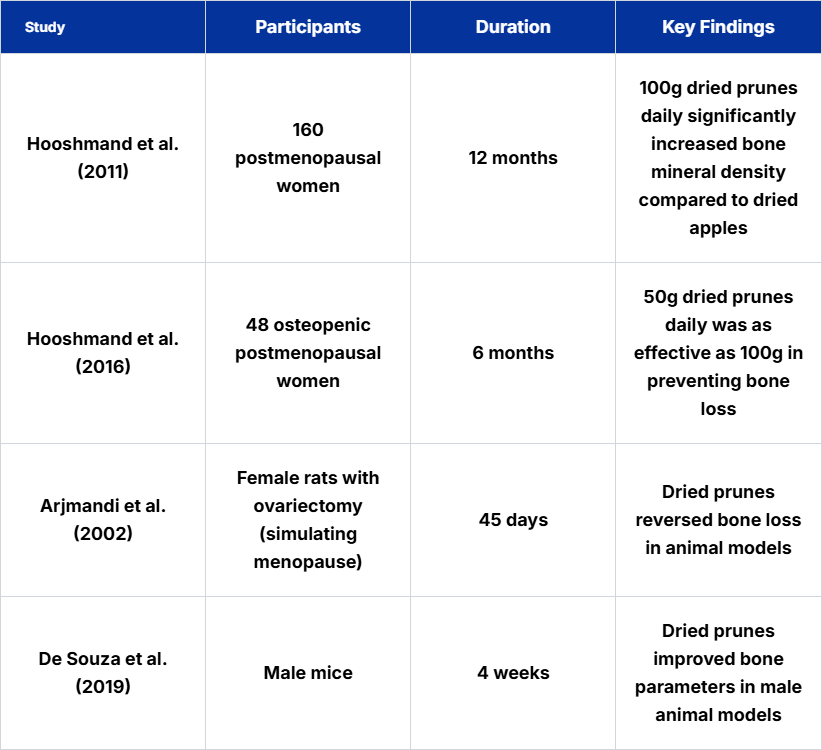
Dried plums work because they suppress excess bone resorption instead of stimulating new osteoblast formation.
This means that since the body becomes senescent and we expect new bone formation to slow down resulting in reduced bone density or skeletal mass for support, dried prunes balance the turnover in a way that allows the body to keep what it has instead of losing it.
“Dried plums contain many phenolic and flavonoid compounds which have been shown to reduce bone resorption through their actions on cell signaling pathways that influence osteoclast differentiation and activity.” – Dr. Bahram H. Arjmandi, Professor of Nutrition at Florida State University
If you suffer from bone-related concerns, it’s recommended to consume 5-6 dried prunes daily (approx. 50g). Some studies recommmaximum impact.ended double this amount .
Combining dried prunes with other bone-supporting nutrients like calcium, vitamin D, and magnesium may provide synergistic benefits for overall skeletal health.
Benefit #3: Heart Health Support

The cardiovascular benefits of dried prunes are extensive and interlinked, providing one of many heart healthy foods that contribute to proper cardiovascular functioning.
Various aspects of dried prunes work with each other to enhance their potential for reducing risks associated with heart disease,the number one killer worldwide.
Dried prunes support heart health through several mechanisms:
Potassium Content and Blood Pressure Regulation
Dried prunes contain approximately 280mg of potassium per 40g servingan affects of sodium levels and promotes vasodilation. An impressive contribution to daily potassium requirements.
Potassium is linked to blood pressure control, helping to mediate the effects. They often recommend the DASH diet (Dietary Approaches to Stop Hypertension) for blood pressure regulation, which indirectly suggests prunes as a healthy option from this category.
A 2010 article in the Journal of Hypertension assessed diastolic and systolic blood pressure levels for those who increased dietary potassium and found a reduction in systolic blood pressure (4.4mmHg lower) and diastolic blood pressure (2.5mmHg lower) for those who increased potassium levels who had been previously deficient. This decrease is comparable to the heart medication some population members use.
Fiber and Cholesterol Management
The soluble fiber found in prunes is effective in reducing LDL (“bad”) cholesterol levels by binding to bile acids in the gastrointestinal system and facilitating their excretion. When bile acids are bound and released, the body has to use cholesterol to produce more bile acids; this serves to decrease cholesterol levels in circulation.
The Journal of Nutritional Science and Vitaminology published a study in which subjects who consumed dried prunes daily had significantly lower LDL levels and better HDL ratios compared to a control group that did not receive daily doses.
Antioxidant Protection for Arteries
Dried prunes also contain neochlorogenic and chlorogenic phenolic compounds that serve as powerful antioxidants. These compounds prevent oxidation of LDL particles, which can contribute to atherosclerosis, and they prevent oxidative stress from damaging arteries.
According to the Journal of Agricultural and Food Chemistry, dried prunes were found to be among the top foods on the USDA database for antioxidant capacity; their ORAC (Oxygen Radical Absorbance Capacity) value is 5770 per 100g serving when compared to other foods over time.
Anti-Inflammatory Effects
Chronic inflammation is a key contributor to cardiovascular disease progression. The bioactive compounds in dried prunes have demonstrated anti-inflammatory properties in multiple studies.
Dried prunes may help protect against the inflammatory processes that damage blood vessels and promote plaque formation.
6 Heart Health Benefits of Dried Prunes:
- Helps maintain healthy blood pressure
- Supports healthy cholesterol levels
- Provides antioxidant protection for arterial walls
- Reduces inflammatory markers associated with heart disease
- Contributes to overall heart-healthy dietary patterns
- Supports healthy endothelial function
For cardiovascular benefits, consistency is key. Incorporating dried prunes regularly as part of a balanced diet rich in fruits, vegetables, whole grains, and healthy fats provides the best foundation for heart health.
Benefit #4: Blood Sugar Control

Prunes are surprisingly good for blood sugar as a food despite their naturally high sweet profile. The contradiction can be understood through their diverse composition and the digestive process.
According to multiple sources, dried prunes have a Glycemic Index (GI) of roughly 29. The glycemic index refers to how fast a food raises blood sugar levels, with lower numbers indicating less of a problem for blood sugar. Therefore, as an approximate 29, dried prunes have a low glycemic index, meaning they should not spike blood sugar levels

Fiber Content and Blood Sugar Regulation:
The value of GI derives from the balance of glucose with other carbs. Soluble fiber is predominant in dried prunes, meaning it creates a gel like texture in the intestines, which absorbing sugar takes longer.
While this compounds the time it takes to digest dried prunes, it prolongs the feeling of fullness satiety(the satisfied feeling of being full after eating) and cross references with their natural content, indicating it’s overall better for the body in terms of insulin absorption and function.
Sorbitol: A Natural Sugar Alcohol
Dried prunes also contain high amounts of sorbitol. Even though it’s counted in their sugar content, in composition with fructose and glucose, sorbitol has a slower absorption rate into the system compared to other sugars.
Phenolic Compounds and Glucose Metabolism
Plenty of phenolic compounds offer another reason why dried prunes are good for blood sugar. For example, chlorogenic acid may alter glucose metabolism according to research. In vitro findings suggest that certain digestive enzymes that work to break down carbohydrates through hydrolytic processes may be inhibited by prunes, which releases less glucose into the bloodstream over time.
Research also shows that eating dried prunes before a meal results in lower postprandial (post-meal) blood glucose levels compared to equivalent carb exchanges from other sources. While this is sometimes confused with initial spikes in blood sugar absorption per meal, prunes show a “second-meal effect” where they help.
Research on Dried Prunes and Blood Sugar Control:
Lorem ipsum dolor sit amet, consectetur adipiscing elit. Ut elit tellus, luctus nec ullamcorper mattis, pulvinar dapibus leo.
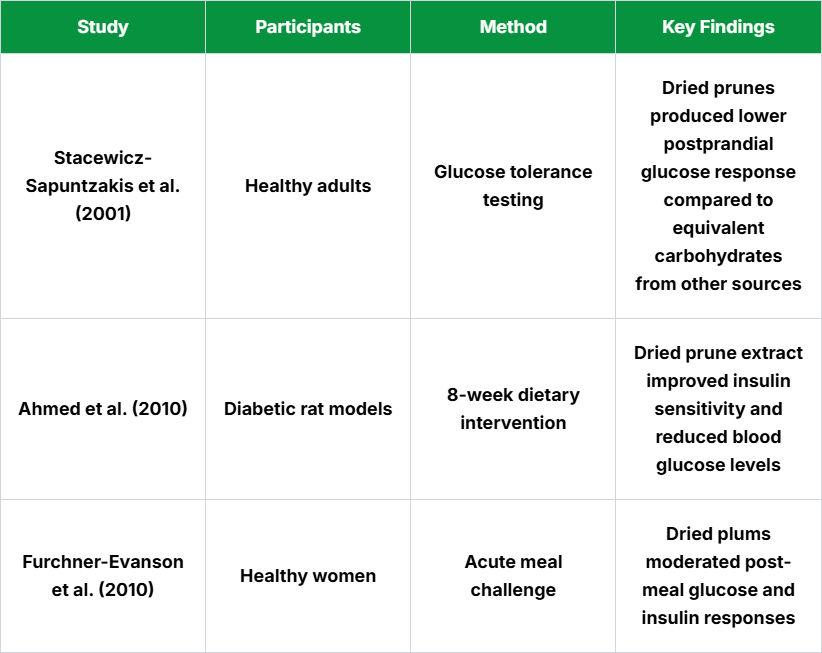
Dried prunes are suitable for those worried about blood sugar levels, such as prediabetes and type 2 diabetes, but moderation is key. Dried prunes help with blood sugar stabilization, but they are still dehydrated and calorie dense carbs.
“Contrary to what might be expected from their sweet taste, dried prunes have demonstrated potential to improve glycemic control when consumed in appropriate portions as part of a balanced diet.” – Dr. Jennifer Erickson, Registered Dietitian and Diabetes Educator
Recommended approaches for blood sugar management:
- Pair dried prunes with a source of protein (like nuts or cheese) to further moderate blood sugar response
- Consume dried prunes as part of a meal rather than alone as a snack
- Start with small portions (2-3 dried prunes) and monitor individual blood sugar response
- Include dried prunes as part of an overall dietary pattern rich in fiber, healthy fats, and lean prote
Benefit #5: Weight Management Support

Regardless of their higher caloric profile, dried prunes have many characteristics that may actually encourage weight loss when following a proper diet. This surprising advantage occurs due to influences on satiety, metabolism, and the gut microbiome.
Satiety and Appetite Regulation
Fiber soluble and insoluble in dried prunes helps stave off hunger. First, soluble fiber absorbs water and swells in the stomach, providing a mechanical sense of satiety that enables people to avoid eating more food.
Second, slow digestion of fiber reduces gastric emptying time, thus maintaining satiety signals for more extended periods, possibly even leading to decreased calories ingested over time.
According to the Journal of Nutrition and Metabolism, “participants who consumed prunes as a snack reported decreased hunger and increased fullness compared with those consuming isocaloric snacks with less fiber,” and “naturally consumed less at subsequent meals” after eating prunes.
Low Energy Density and Glycemic Control
While they’re high in calories, dried prunes are low on the glycemic index, allowing for stable blood sugar levels, meaning one is less likely to experience spikes and crashes in blood sugar, which causes feelings of hunger and cravings.
Instead, these stable levels mimic the stability pruned provide over time, so energy comes through at a continuous level rather than short bursts, allowing people to go longer between meals without the need for snacks and cutting down on overall caloric intake.
Positive Effects on Gut Microbiome
Research is still under investigation, but studies show that dried prunes positively impact the gut microbiome, which increasingly helps maintain a healthy weight.
The fiber in dried prunes functions as a prebiotic, feeding beneficial gut bacteria that produce short-chain fatty acids (SCFAs). These SCFAs have been linked to improved metabolic health, enhanced fat oxidation, and better weight management.
A 2015 study in Nutrients journal found that dietary interventions promoting SCFA production through prebiotic fibers were associated with reduced weight gain and fat accumulation in research subjects.
Metabolic Benefits
Some studies suggest that the dried prune phenolic compounds might impact metabolism by regulating pathways responsible for fat deposit and energy expenditure, meaning more human studies are needed in this field but preliminary findings show these compounds may assist in:
- Increase adiponectin levels (a hormone that enhances fat burning)
- Improve insulin sensitivity
- Reduce inflammation associated with obesity
- Support healthy mitochondrial function
Practical Weight Management Strategies with Dried Prunes:
- Portion control is crucial: Limit consumption to 4-5 dried prunes (approximately 30-40g) per serving
- Timing matters: Consume dried prunes before meals or as part of a balanced snack to maximize satiety benefits
- Pair strategically: Combine dried prunes with protein sources (like Greek yogurt or nuts) to enhance fullness
- Stay hydrated: Drink plenty of water when consuming dried prunes to help the fiber expand and promote satiety
- Use as a sugar substitute: Replace refined sugars in recipes with pureed dried prunes to reduce overall sugar intake while adding fiber
“When incorporated mindfully into a balanced diet, dried prunes can actually support weight management goals through their impact on satiety hormones and blood glucose regulation. The key is moderation and strategic timing.” – Dr. Michael Jensen, Obesity Researcher
Dried prunes for weight loss do not work on their own but rather as part of an overall calorie sensible, nutrient dense eating pattern and alongside regular exercise for successful weight maintenance.
Benefit #6: Antioxidant Protection
Of all fruits and veggies, dried prunes are some of the best sources of antioxidants. Antioxidants are a substantial contributor to the health benefits and disease preventative claims of prunes.
Antioxidants are compounds that help neutralize free radicals—unstable molecules that can damage cells through oxidative stress.
This cellular damage is implicated in aging processes and the development of numerous chronic diseases, including cardiovascular disease, cancer, and neurodegenerative conditions. By counteracting free radicals, the antioxidants in dried prunes help protect cells and tissues throughout the body.
Key Antioxidant Compounds in Dried Prunes:
Dried prunes contain several classes of antioxidant compounds that work through different mechanisms to provide comprehensive protection:
- Phenolic acids: Including neochlorogenic acid and chlorogenic acid, which are particularly abundant in dried prunes
- Flavonoids: Including quercetin and rutin, which have demonstrated potent antioxidant effects
- Carotenoids: Including beta-carotene and lutein, which protect against lipid peroxidation
- Vitamin C: Though present in modest amounts, contributes to the overall antioxidant activity
The ORAC value (Oxygen Radical Absorbance Capacity) for dried prunes is about 8,059 μmol TE per 100g which is much higher than most fruits. For example, fresh blueberries (which are heralded for their antioxidants) have an ORAC value of approximately 4,669 μmol TE per 100g.
Synergistic Effects
The interconnected nature of various antioxidants in dried prunes makes their profile even more potent. It has been found that the simultaneous action of several antioxidants is more protective than several individual actions.
Hence, whole foods, such as dried prunes, are often found to be beneficial for health more than the sum of their parts.
Research on Dried Prunes’ Antioxidant Effects:
A study published in the Journal of Agricultural and Food Chemistry explored the antioxidant potential of dried prunes and the extent to which they prevent LDL cholesterol oxidation, a crucial process in atherosclerosis formation.
Researchers found that dried prune extract decreased LDL oxidation and the researchers concluded that this response may be a contributor to cardioprotective potential.
A study published in the British Journal of Nutrition evaluated the impact of dried prune intake on indicators of oxidative stress in postmenopausal women.
Researchers found that after six weeks, those who consumed dried prunes showed decreased plasma F2-isoprostanes versus the control groups with significant results.
Antioxidant Benefits Throughout the Body:
The wide-ranging antioxidant protection offered by dried prunes may benefit multiple body systems:
- Cardiovascular system: Protection against LDL oxidation and arterial damage
- Nervous system: Defense against oxidative stress implicated in cognitive decline
- Digestive system: Reduction of oxidative damage to the intestinal lining
- Musculoskeletal system: Protection against oxidative processes that contribute to inflammation
- Skin: Defense against UV-induced oxidative damage and premature aging
Comparative Antioxidant Content of Common Foods:

“The phenolic compounds in dried prunes not only exhibit direct antioxidant activity but also appear to upregulate the body’s endogenous antioxidant defenses, essentially teaching our cells to better protect themselves.” Dr. Navindra Seeram, Medicinal Plant Researcher
While dried prunes should be a part of one’s diet for the best antioxidant advantages, they can also soak up a good portion of antioxidants in a more diversified diet of other rainbow fruits and vegetables for a protective advantage against oxidative stress and dangers to health.
Benefit #7: Vision Support
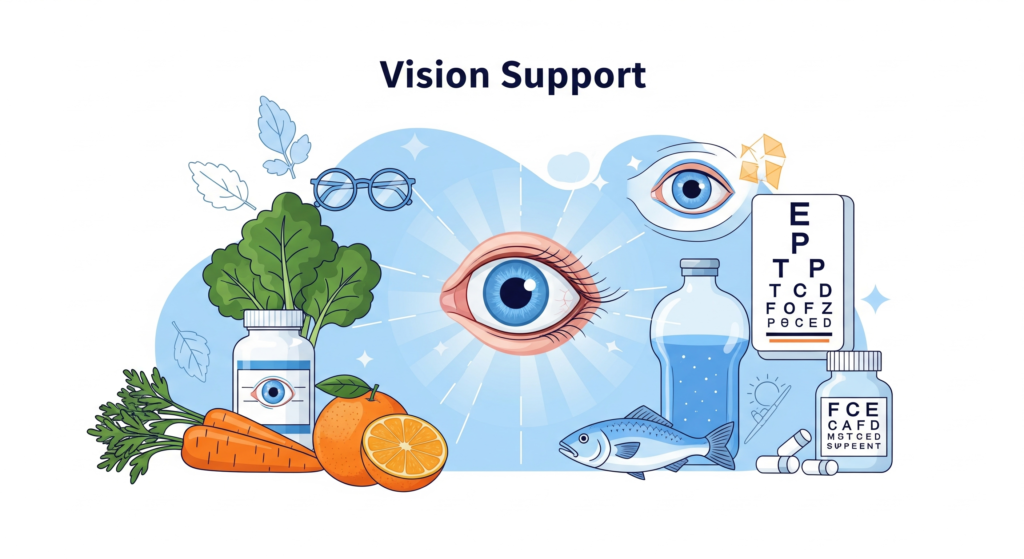
Visual benefits of dried prunes (though their digestive or bone associations are more common) highlight a second physiological quality they’re known for.
Therefore, nutrients and bioactive compounds in dried prunes promote eye health, which can help prevent age related eye issues, too.
Key Vision-Supporting Nutrients in Dried Prunes:
Vitamin A and Carotenoids
Vitamin A and carotenoid compounds exist in dried prunes. Although these compounds accumulate in higher values as lutein/zeaxanthin which the body can convert from beta carotene.
Beta carotene exists in a way that the body can convert it to vitamin A if it needs to. Vitamin A helps sustain the photoreceptors in the retina and is required in the production of rhodopsin, a protein needed for the eyes to adapt to gradual changes in light.
It’s also important to maintain the cornea and conjunctival membranes that protect the eye. One serving (40g) of prunes has about 213 IU of vitamin A, or a 40th part of what is needed per day to foster healthy vision.
Lutein and Zeaxanthin
These carotenoids accumulate in the macula of the eye and serve as natural “sunglasses,” absorbing blue light that might harm the macula and causing oxidative stress.
Although the levels are not as high as in dark, leafy greens or yellow-orange veggies, the lutein and zeaxanthin found in dried prunes still helps add to the intake of these vital pigments for the macula.
According to an article published in the Journal of Nutrition, the higher intake of lutein and zeaxanthin as part of one’s diet, the less risk a person has for developing age-related macular degeneration (AMD), a common degenerative condition for eyesight.
Antioxidant Protection for Ocular Tissues
These phenolic compounds and additional antioxidants found in dried prunes protect against oxidative stress more extensively, as oxidative stress hits the eye tissues even harder.
Furthermore, the eyes are particularly vulnerable to oxidized damage because of high oxygen consumption, high exposure to light, and high levels of polyunsaturated fatty acids.
According to a study published by the Archives of Ophthalmology, higher total antioxidant consumption had a correlation with reduced risks of dry and wet types of AMD; therefore, it can be presumed that such foods that contain a variety of antioxidants, like dried prunes promote visual longevity.
Glycemic Control and Eye Health
Dried prunes may help promote healthy blood sugar levels which indirectly assist eye health; blood glucose fluctuation and insulin resistance are risk factors for diabetic retinopathy and other eye related issues.
Given that dried prunes are low glycemic, they could help reduce these risks through improved glycemic control.
Research on Dietary Patterns and Vision Protection:
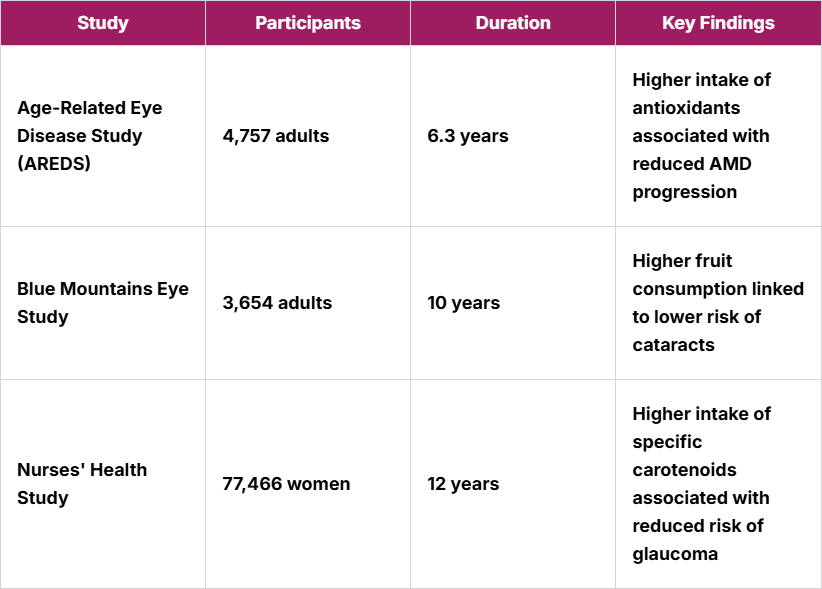
While dried prunes alone cannot prevent all age related vision changes, they can be part of a comprehensive approach to eye health that includes:
- A diet rich in colorful fruits and vegetables
- Adequate intake of omega-3 fatty acids
- Protection from UV exposure
- Regular eye examinations
- Smoking cessation
- Blood pressure and blood sugar management
Practical Tips for Supporting Vision Health:
- Combine dried prunes with other vision supporting foods like nuts (for vitamin E) and orange vegetables (for additional carotenoids)
- Consume dried prunes regularly as part of a balanced diet that includes a variety of antioxidant rich foods
- Pair dried prunes with sources of healthy fats to enhance absorption of fat-soluble carotenoids
“The multifaceted approach to vision protection involves not just singular nutrients but dietary patterns rich in diverse antioxidants and plant compounds. Dried prunes contribute to this protective matrix through their unique nutrient profile.” – Dr. Emily Chew, Deputy Clinical Director at the National Eye Institute
If you’re someone who wants to maintain vision, especially in older age, adding dried prunes to your nutrient rich diet is a reasonable and tasty way to promote long term eye health.
Benefit #8: Anemia Prevention
Iron deficiency anemia is a global concern impacting millions. From women of childbearing years to pregnant women and vegetarians, it seems that many people are vulnerable to this condition.
Dried prunes are an iron rich food source for a natural treatment approach, providing vegans with necessary iron while helping to prevent mild iron deficiency anemia when eaten at strategic intervals.
A serving of 40g (approximately 5-6 dried prunes) contains roughly 0.4mg of iron which is about 2-5% of the daily recommended value depending upon age and sex.
While not as iron-rich as animal sources like liver or red meat, dried prunes have several advantages as a complementary iron source:
Non-Heme Iron with Enhanced Absorption
Dried prunes are non-heme iron, the type of iron that exists in food of plant origin. Non-heme iron is less absorbable than the heme iron found in animal products; however, dried prunes differ because they also possess vitamin C and organic acids that work to improve absorption.
These components render iron more absorbable and also render it less prone to binding with other components that would decrease absorption.
Complementary Nutrients for Red Blood Cell Production
Beyond iron, dried prunes provide several nutrients that support red blood cell production and function:
- Copper: Essential for iron absorption and utilization in hemoglobin synthesis
- B vitamins: Contribute to red blood cell formation and function
- Vitamin K: Important for proper blood clotting
- Antioxidants: Protect red blood cells from oxidative damage
Synergistic Consumption Strategies
To maximize the iron benefits of dried prunes, consider these evidence-based strategies for enhancing absorption:
- Combine with vitamin C sources: Pairing dried prunes with citrus fruits, bell peppers, or strawberries can significantly increase iron absorption
- Avoid simultaneous consumption with calcium-rich foods: Calcium can temporarily inhibit iron absorption, so separate dried prune consumption from dairy products by at least an hour
- Pair with vitamin A-rich foods: Research suggests vitamin A helps mobilize iron stores, making combinations like dried prunes with carrots particularly effective
- Consider cooking method impacts: Cooking in cast iron cookware can increase the iron content of acidic foods that might be served alongside dried prunes
According to a study published in the British Journal of Nutrition, a clinical trial was conducted to observe the impacts of dried fruit consumption on iron status indices in women with marginal iron deficiency anemia.
It was found that after 12 weeks, those who consumed a portion of mixed dried fruits (prunes included) daily showed increased ferritin levels over the control group
“While dried prunes shouldn’t be relied upon as a primary treatment for significant anemia, their contribution to overall iron intake and their complementary nutrients make them a valuable component of a comprehensive approach to iron status maintenance.” Dr. Laura Richards, Hematology Researcher
Case Study: Supporting Iron Levels During Pregnancy
Maria was 32 years old, pregnant, vegetarian and in her second trimester. She was worried about her iron levels because she was avoiding her usual high dose iron supplements due to gastrointestinal distress.
Her prenatal dietitian suggested she add dried prunes to her breakfast oatmeal (with some ground flaxseeds and berries, of course) to help.
This was because there are various plant sources of iron, but also, the additional elements would help absorb the iron better. In subsequent months, Maria’s hemoglobin was stable and her reliance on iron supplements was getting smaller and smaller.
If you are including dried prunes as an anemia-prevention option, do it consistently!
The more they’re eaten as part of an iron-rich collection of foods over time, the better they’ll work.
Benefit #9: Immune System Enhancement

Dried prunes promote immune-supporting properties because of their vast array of nutrients and bioactive components that work synergistically to bolster different aspects of immunity.
While they’re not necessarily known as an “immune food” like citrus or yogurt, they should be appreciated for their role in making the body more resilient.
Nutrient Foundation for Immune Function
Dried prunes provide several essential nutrients that serve as building blocks for a healthy immune system:
- Vitamin B6: Supports biochemical reactions in the immune system and is essential for protein metabolism involved in creating new immune cells
- Copper: Critical for immune cell development and function, particularly neutrophils and monocytes
- Iron: Required for proper immune cell proliferation and maturation
- Vitamin A: Essential for maintaining the integrity of mucosal barriers, the body’s first line of defense against pathogens
Antioxidant Protection for Immune Cells
The immune system is especially susceptible to oxidative injury since immune cells generate reactive oxygen species during their normal operation.
Therefore, the wide array of antioxidants in dried prunes namely, phenolic antioxidants may confer protection on such immune cells from such endogenously created oxidative stress and may even lengthen their life and enhance their functioning.
Research in Journal of the Nutritional Biochemistry, some of the phenolic compounds present in dried prunes can regulate oxidative burst in neutrophils, which is how these immune cells kill foreign pathogens with reactive oxygen species without too much damage to their neighbor cells.
Gut Microbiome Support and Immune Function
About 70% of your immune system is found in your gut, so it’s important to keep your gut healthy. The fiber from dried prunes acts as a prebiotic to the good bacteria in your gut that produce short-chain fatty acids (SCFAs). SCFAs are known to modulate immune function in many ways:
- Promoting the development and function of regulatory T cells, which help prevent autoimmunity
- Strengthening the intestinal barrier, preventing “leaky gut” that can trigger inflammation
- Modulating the production of antimicrobial peptides that help control pathogen populations
According to a 2019 study published in the Journal of Nutritional Biochemistry, dried plum intake positively altered the gut microbiome composition by increasing advantageous Bacteroidetes and decreasing pathogenic Firmicutes, a composition more associated with better immune function.
Anti-Inflammatory Effects
Chronic inflammation can exhaust immunological reserves and compromise response to future challenges. The polyphenols found in dried prunes have been shown to possess anti-inflammatory qualities to maintain an even inflammatory response that aids immune functioning instead of complicating it.
Research on Dried Prunes and Immune Function:

Practical Immune-Supporting Strategies:
- Consume dried prunes regularly to maintain consistent levels of immune-supporting nutrients
- Combine with zinc-rich foods like pumpkin seeds to create a more comprehensive immune-supporting snack
- Add to yogurt for a synergistic effect on gut health and immunity
- Include in recovery meals after intense exercise, when immune function may be temporarily suppressed
The relationship between nutrition and immunity is complex, but dried prunes offer multiple mechanisms of support from providing basic immune nutrients to modulating the gut immune axis through prebiotic effects.” Dr. Susan Percival, Immunology and Nutrition Researcher
For optimal immune benefits, dried prunes should be incorporated as part of a diverse diet rich in colorful plant foods, adequate protein, and healthy fats.
Benefit #10: Anti-Inflammatory Properties

Chronic inflammation is linked to many debilitating and life threatening conditions, such as cardiovascular disease, type 2 diabetes, arthritis, and some cancers.
Many bioactive compounds in dried prunes possess anti-inflammatory properties, which allows them to fit into an anti-inflammatory eating pattern.
Bioactive Compounds with Anti-Inflammatory Effects
The anti-inflammatory properties of dried prunes stem primarily from their polyphenolic compounds:
- Neochlorogenic acid and chlorogenic acid: These phenolic acids inhibit the production of pro-inflammatory cytokines like tumor necrosis factor-alpha (TNF-α) and interleukin-6 (IL-6)
- Quercetin and other flavonoids: Help suppress the activation of NF-κB, a key transcription factor in inflammatory responses
- Anthocyanins: Contribute to reduced inflammatory signaling in vascular tissues
- Potassium: Helps counteract inflammatory responses associated with high sodium intake
Systemic Inflammation Reduction
A journal study in the Journal of Nutritional Biochemistry explored the impact of dried plum (prune) consumption on inflammatory responses in postmenopausal women.
Researchers discovered that after dried prune consumption, circulating pro-inflammatory cytokines and C-reactive protein (CRP) a universal marker of inflammation decreased significantly after intake in the measured groups.
Additionally, the British Journal of Nutrition also found that people who consumed dried prunes daily and had mildly elevated cholesterol levels had lower inflammatory biomarkers than their counterparts, indicating further implications for inflammation reduction.
Systemic Inflammation Reduction
A study published by the Journal of Nutritional Biochemistry takes it a step further to assess markers of inflammation due to dried plum consumption in postmenopausal women. They found a significant decrease in circulating pro-inflammatory cytokines and C-reactive protein (CRP), an indication of systemic inflammation, post-consumption of dried prunes.
inflammation, post-consumption of dried prunes.
A second study performed by the British Journal of Nutrition reports that daily intake of dried prunes decreased inflammatory biomarkers in mildly hypercholesterolemic study participants, indicating that consumption can lower related inflammatory risks.
Joint Health and Arthritis Management
These polyphenols in dried prunes also have a special connection to joints. No human clinical trials have researched dried prunes for arthritis treatment, but lab and animal studies show polyphenols as anti-arthritic.
For example, one study published by Arthritis Research & Therapy shows that polyphenols resembling those found in dried prunes decrease cartilage destruction and inflammatory responses in osteoarthritis models, as well as protect joint tissue.
Anti-Inflammatory Effects in Various Body Systems:
- Cardiovascular system: Reduced endothelial inflammation and improved vascular function
- Gastrointestinal tract: Decreased intestinal inflammation and enhanced barrier function
- Musculoskeletal system: Potential reduction in joint inflammation and protection against cartilage degradation
- Neurological system: Possible neuroprotective effects through reduced neuroinflammation
- Respiratory system: Moderation of inflammatory responses in lung tissues
Clinical Applications and Recommendations
While dried prunes alone cannot treat inflammatory conditions, they can be part of a comprehensive anti-inflammatory approach that includes:
- A predominantly plant-based diet rich in colorful fruits and vegetables
- Adequate omega-3 fatty acid intake
- Limited consumption of refined carbohydrates and industrial seed oils
- Regular physical activity
- Stress management practices
- Adequate sleep
“The most effective anti-inflammatory strategies involve multiple dietary components working synergistically. Dried prunes contribute to this approach through several mechanisms, including their unique polyphenol profile and prebiotic effects.” Dr. Barry Sears, Inflammation Researcher
For those seeking anti-inflammatory benefits, consistency is important occasional consumption is less likely to produce measurable effects than regular inclusion of dried prunes in the diet.
Benefit #11: Skin Health Promotion
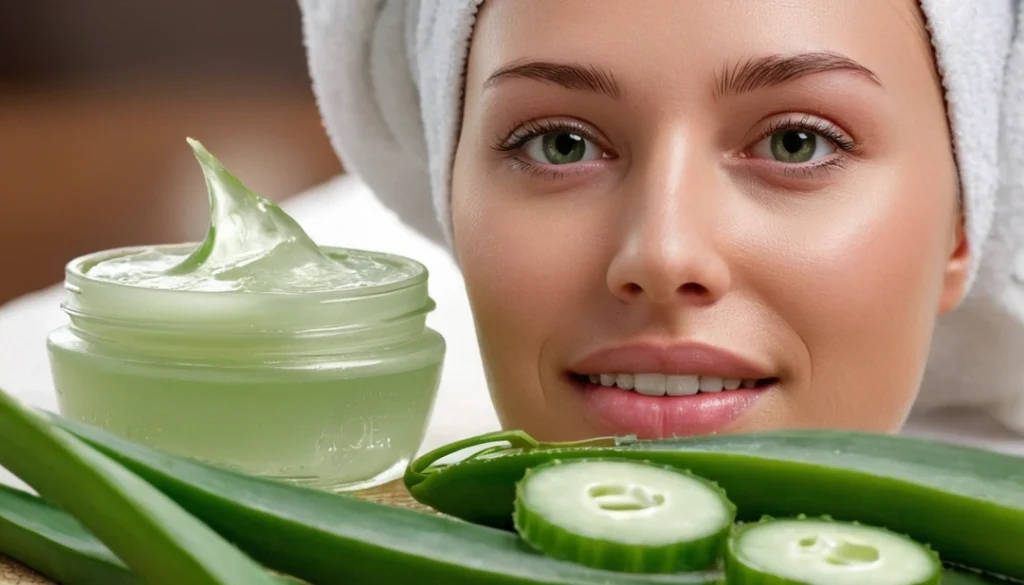
The skin improving qualities of dried prunes come from their myriad of nutrients and bioactive compounds that nourish the skin’s structure, provide protection from the inside out and deliver a radiant appearance from within.
Dried prunes may not be a conventional “beauty food”, but they boast evidence based advantages when it comes to skin that is healthy, supple, and strong.
Antioxidant Protection Against Photo-Aging
Environmental aggressors plague the skin with the most common being UV light that creates free radicals and ages the skin faster.
Dried prunes are said to contain large amounts of antioxidants, like neochlorogenic acid, chlorogenic acid and other phenolic compounds, which combat free radicals from the inside out for potentially less oxidative stress that contributes to skin creasing, aging, and laxity.
According to research published in the Journal of Cosmetic Dermatology, a cross sectional study between common dietary antioxidants and dermatological assessments found that female participants who consumed higher levels of dietary antioxidants, the better the elasticity of the skin and the decreased signs of photo-aging.
Collagen Support and Synthesis
Collagen, the primary structural protein in skin, requires specific nutrients for proper formation and maintenance. Dried prunes contribute several collagen-supporting nutrients:
- Copper: Essential for activating lysyl oxidase, an enzyme required for collagen cross-linking and stability
- Vitamin C: Though present in modest amounts, contributes to the hydroxylation of proline and lysine in collagen synthesis
- Boron: May help maintain healthy levels of steroid hormones that influence skin health and collagen production
Hydration Support Through Sorbitol
Healthy skin requires proper moisture to remain smooth and plump while also functioning as an effective barrier.
The sorbitol content in dried prunes may play a part in skin moisture when eaten on a regular basis as part of a healthy diet, as it is a humectant that draws in moisture and retains it.
Sorbitol in cosmetics is used topically for its moistening properties. When eaten, it could provide similar results from the inside out.
Blood Flow and Nutrient Delivery
Similarly, dried prunes are good for skin due to improved microcirculation as a result of cardiovascular benefits. Increased blood flow to the skin helps with oxygen and nutrient delivery and waste removal.
The blood vessels that receive such elements in dried prunes and the antioxidants are better able to manage such systems, possibly improving one’s vascular highway to the skin.
Anti-Inflammatory Effects for Skin Comfort
Skin irritation can occur as redness, inflammation, or pimples. Dried prunes contain anti-inflammatory properties that may promote less inflammatory responses in the body, even in skin tissues.
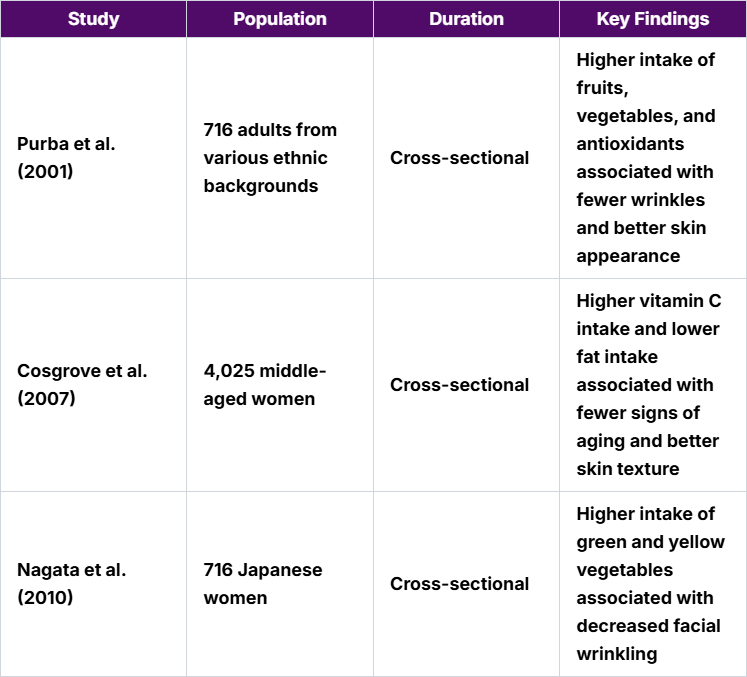
Practical Applications for Skin Health:
- Incorporate dried prunes into a skin-supporting diet rich in colorful plant foods, omega-3 fatty acids, and adequate protein
- Pair dried prunes with vitamin E-rich foods like almonds for synergistic antioxidant protection
- Stay well-hydrated when consuming dried prunes to maximize their potential hydration benefits
- Consider dried prunes as part of a holistic approach to skin health that includes sun protection, adequate sleep, and stress management
“The skin is ultimately a reflection of internal health. Foods like dried prunes that support multiple bodily systems, from digestion to circulation, create a foundation for healthy skin that no topical product can replicate.” Dr. Jessica Wu, Dermatologist and Nutritional Skin Expert
For optimal skin benefits, dried prunes should be consumed regularly as part of a varied, nutrient-dense diet that provides a broad spectrum of skin-supporting compounds.
Benefit #12: Culinary Versatility

Beyond their nutritional benefits, dried prunes possess remarkable culinary versatility that’s sure to make healthy eating easier and more enjoyable.
Their flavor sweet and slightly tart with an undertone of caramel and complexity,adds something special and complementary to many meals, from breakfast to lunch and dinner to dessert.
Sweet and Savory Applications
One of the most remarkable aspects of dried prunes is their ability to excel in both sweet and savory dishes:
Sweet Applications:
- Breakfast cereals, oatmeal, and granola
- Baked goods like muffins, scones, and cookies
- Yogurt parfaits and smoothie bowls
- Homemade energy bars and balls
- Natural sweetener in place of refined sugars
Savory Applications:
- Moroccan tagines and stews
- Stuffing for poultry or pork
- Grain salads with nuts and herbs
- Charcuterie and cheese boards
- Sauces for meat dishes (particularly complementary with chicken, pork, and lamb)
Natural Sugar Replacement
Dried prunes can be a fantastic replacement for refined sugars in much of culinary arts due to their naturally sweet, concentrated sugars.
Prune puree can substitute half or even all of the sugar in baked items, where it also helps retain moisture, cuts down fat content, and provides benefits that sugar does not boast.
According to a study from the Journal of the Academy of Nutrition and Dietetics, researchers tested baked items with an attempt to substitute butter and sugar with prune puree and found such baked goods sensorially acceptable and nutritionally enhanced.
Recipe: Prune Puree for Baking
- 1 cup dried prunes
- 1/3 cup hot water
- Soak prunes in hot water for 10 minutes, then blend until smooth
- Use in place of equal amounts of butter, oil, or up to half the sugar in recipes
Texture Enhancement
The one-of-a-kind dried prune texture (chewy, but soft) makes for interesting mouthfeel in many applications. Chopped, they can add nice textural contrast to salads, grain bowls and baked items.
Pureed, they can add moisture and a binding component which assists in texture for energy bars and meat loaves, for example.
Flavor Balancing
The complex flavor profile of dried prunes includes sweet, tart, and umami notes that can balance and enhance other flavors in a dish:
- Their sweetness balances acidic ingredients like vinegar or tomatoes
- Their subtle tartness brightens rich, fatty foods
- Their umami qualities complement proteins and add depth to savory dishes
Global Culinary Traditions
Dried prunes have a rich culinary history across multiple food cultures:
- French cuisine: Used in classic dishes like pruneaux d’Agen and duck with prunes
- Middle Eastern cooking: Incorporated into meat stews with warming spices
- Eastern European traditions: Featured in compotes and baked goods
- North African cuisine: Added to tagines with lamb and aromatic spices
- California cuisine: Used in modern, health-focused preparations
Chef Insights on Cooking with Dried Prunes:
“Dried prunes are a chef’s secret weapon. They add dimension to both sweet and savory dishes with their natural sweetness and umami notes. I particularly love them in slow cooked meat dishes where they break down and create an incredible depth of flavor.” Chef Amanda Cohen, Culinary Institute of America Graduate
Practical Culinary Applications:
- Breakfast: Add chopped dried prunes to overnight oats with cinnamon and walnuts
- Lunch: Incorporate into grain salads with quinoa, roasted vegetables, and herbs
- Snacks: Combine with nuts and dark chocolate for a trail mix
- Dinner: Use in slow-cooked tagines or braises with aromatic spices
- Dessert: Poach in red wine with vanilla and serve with mascarpone
Recipe Development Tips:
- Chop finely when incorporating into baked goods for even distribution
- Plump in hot liquid before adding to dry dishes to enhance moisture and texture
- Pair with complementary spices like cinnamon, cardamom, and star anise
- Balance their sweetness with acidic ingredients like citrus or vinegar in savory dishes
- Combine with nuts like walnuts or almonds to create textural contrast
The culinary versatility of dried prunes makes them an exceptionally practical superfood one that can be enjoyed in countless creative ways while delivering impressive nutritional benefits.
How to Incorporate Dried Prunes Into Your Diet
Dried prunes and their versatile characteristics make them easy additions to a healthful eating plan on a daily basis. Below are practical and tasty ways to consume dried prunes on a daily basis while avoiding monotony:
Daily Consumption Recommendations
While most nutritional professionals suggest eating 4-6 dried prunes per day (roughly 30-40g) for optimal health benefits, as this is enough to reap sufficient nutritional rewards without excess calories and sugars, it might be best to adjust these numbers based on health needs:
- For digestive regularity: 5-6 dried prunes daily
- For bone health support: 5-6 dried prunes daily (studies have used up to 10-12)
- For weight management support: 2-4 dried prunes as part of a balanced snack
Breakfast Ideas
- Prune-Infused Oatmeal: Add chopped dried prunes to oatmeal along with cinnamon and a sprinkle of walnuts
- Yogurt Parfait: Layer Greek yogurt with chopped dried prunes, toasted nuts, and a drizzle of honey
- Breakfast Smoothie: Blend soaked dried prunes with yogurt, banana, and almond milk for a fiber-rich start to the day
- Whole Grain Toast: Spread toast with ricotta cheese and top with chopped dried prunes and a sprinkle of pistachios
- Prune Butter: Blend soaked dried prunes into a spread for toast or English muffins
Lunch and Dinner Applications
- Grain Bowls: Add chopped dried prunes to quinoa or farro bowls with roasted vegetables and tahini dressing
- Salad Enhancer: Incorporate into salads with bitter greens, blue cheese, and walnuts
- Meat Companion: Use in slow-cooked dishes with chicken, pork, or lamb
- Sauce Component: Blend into reduction sauces for a natural sweetener with depth
- Couscous or Pilaf: Mix chopped dried prunes into warm grain dishes with herbs and spices
Snack Suggestions
- Trail Mix: Combine dried prunes with almonds, dark chocolate chips, and coconut flakes
- Energy Balls: Pulse dried prunes with nuts, oats, and spices for no-bake energy bites
- Cheese Pairing: Serve with aged cheeses like manchego or parmesan for a sweet-savory contrast
- Stuffed Prunes: Fill with almond butter or a small piece of dark chocolate for a sweet treat
- Prune and Nut Bars: Make homemade bars with dried prunes, nuts, seeds, and minimal added sweeteners
Cooking and Baking Applications
- Natural Sweetener: Use pureed dried prunes to replace some or all of the sugar in baking recipes
- Fat Replacement: Substitute prune puree for some of the butter or oil in baked goods
- Meat Tenderizer: Add to marinades for meats to help tenderize and add flavor
- Stew Thickener: Use pureed dried prunes to add body and richness to stews and sauces
- Compotes and Chutneys: Create sweet or savory preserves with dried prunes as a base
Recipe: Moroccan-Inspired Prune and Chicken Tagine
Ingredients:
- 1 lb chicken thighs
- 1 onion, diced
- 2 cloves garlic, minced
- 1 tbsp ginger, grated
- 1 tsp cinnamon
- 1/2 tsp cumin
- 1/4 tsp turmeric
- 1 cup chicken broth
- 12 dried prunes, halved
- 1/4 cup sliced almonds
- Fresh cilantro for garnish
Instructions:
- Brown chicken thighs in olive oil in a Dutch oven
- Add onion, garlic, ginger, and spices; sauté until fragrant
- Pour in chicken broth, add dried prunes, and simmer covered for 30 minutes
- Toast almonds and sprinkle over the dish before serving with couscous
- Garnish with cilantro
Practical Tips for Maximum Enjoyment
- Storage: Keep dried prunes in an airtight container in a cool, dark place for up to 6 months, or refrigerate for longer shelf life
- Rehydration: Soak tough or very dry prunes in hot water or tea for 10-15 minutes before using
- Chopping: Lightly oil your knife to prevent sticking when chopping dried prunes
- Portion control: Pre-portion dried prunes into small containers or bags for convenient, controlled snacking
- Flavor pairings: Experiment with complementary flavors like orange, cinnamon, vanilla, star anise, and warming spices
By incorporating dried prunes in these diverse ways, you can enjoy their health benefits consistently without palate fatigue while enhancing the nutritional value of your meals and snacks.
Potential Side Effects and Considerations
Though dried prunes provide many health benefits, they aren’t suitable for everyone all the time.
Knowing side effects and cautions can allow you to enjoy dried prunes to your advantage without having them backfire on you.
Digestive Considerations
Laxative Effects
The most well-known side effect of dried prunes is their laxative action, which can be either beneficial or problematic depending on individual circumstances:
- Benefits: For those with constipation or seeking digestive regularity, this effect is desirable
- Concerns: Consuming too many dried prunes too quickly can lead to digestive discomfort, cramping, loose stools, or diarrhea
Recommended approach: Start with a small serving (2-3 dried prunes) and gradually increase as tolerated. Space consumption throughout the day rather than eating a large amount at once.
Conclusion
Dried prunes are a nutrient dense superfood backed by substantial scientific evidence.
From digestive health and bone strength to heart support and blood sugar control, they offer wellness advantages that few other foods can match.
Their unique combination of fiber, phenolic compounds, vitamins, and minerals creates synergistic effects throughout the body. Best of all, they’re shelf-stable, portable, and versatile making consistent consumption both easy and enjoyable.
Start with 4-6 dried prunes daily and discover how this humble fruit can meaningfully contribute to your long-term health and wellness goals.
Frequently Asked Questions
How many dried prunes should I eat per day?
For general health benefits, nutrition experts recommend 4-6 dried prunes (approximately 30-40g) daily. For specific concerns like digestive regularity or bone health, some studies have used up to 10-12 dried prunes daily. Start with a smaller amount and gradually increase to assess your individual tolerance and response.
Can dried prunes help with constipation immediately?
Dried prunes typically begin working within 6-12 hours for most people, though individual response varies. For best results, consume them consistently rather than only when experiencing constipation. The combination of fiber, sorbitol, and phenolic compounds provides both immediate and long-term digestive benefits.
Are dried prunes the same as fresh plums?
Dried prunes are made from specific varieties of European plums that have been dehydrated. The drying process concentrates nutrients, fiber, and natural sugars, making dried prunes nutritionally different and more concentrated than fresh plums. Both offer health benefits, but dried prunes provide higher levels of certain nutrients per serving.
Can people with diabetes eat dried prunes?
Yes, despite their sweetness, dried prunes have a low glycemic index (29) and can be part of a diabetes-friendly diet when consumed in appropriate portions. The fiber content helps moderate blood sugar response. However, people with diabetes should account for the carbohydrate content (about 25g per 40g serving) in their meal planning and monitor their individual blood sugar response.
Will eating dried prunes cause weight gain?
Dried prunes are calorie-dense (about 96 calories per 40g serving), but they can actually support weight management when consumed in appropriate portions. Their fiber content promotes satiety, helping reduce overall calorie intake. The key is portion control and incorporating them as part of a balanced, calorie-appropriate diet.
Contents
- 1 12 Benefits of dried prunes
- 1.1 Health benefits
- 1.2 Introduction
- 1.3 What Are Dried Prunes?
- 1.4 Benefits of dried prunes
- 1.5 Benefit # 1: Digestive Health and Regularity
- 1.6 Benefit #2: Bone Strength and Osteoporosis Prevention
- 1.7 Benefit #3: Heart Health Support
- 1.8 Dried prunes support heart health through several mechanisms:
- 1.9 6 Heart Health Benefits of Dried Prunes:
- 1.10 Benefit #4: Blood Sugar Control
- 1.11 Benefit #5: Weight Management Support
- 1.12 Benefit #6: Antioxidant Protection
- 1.13 Benefit #7: Vision Support
- 1.14 Benefit #8: Anemia Prevention
- 1.15 Benefit #9: Immune System Enhancement
- 1.16 Benefit #10: Anti-Inflammatory Properties
- 1.17 Benefit #11: Skin Health Promotion
- 1.18 Benefit #12: Culinary Versatility
- 1.19 How to Incorporate Dried Prunes Into Your Diet
- 1.20 Potential Side Effects and Considerations
- 1.21 Conclusion
- 1.22 Frequently Asked Questions
- 1.23 How many dried prunes should I eat per day?
- 1.24 Can dried prunes help with constipation immediately?
- 1.25 Are dried prunes the same as fresh plums?
- 1.26 Can people with diabetes eat dried prunes?
- 1.27 Will eating dried prunes cause weight gain?
